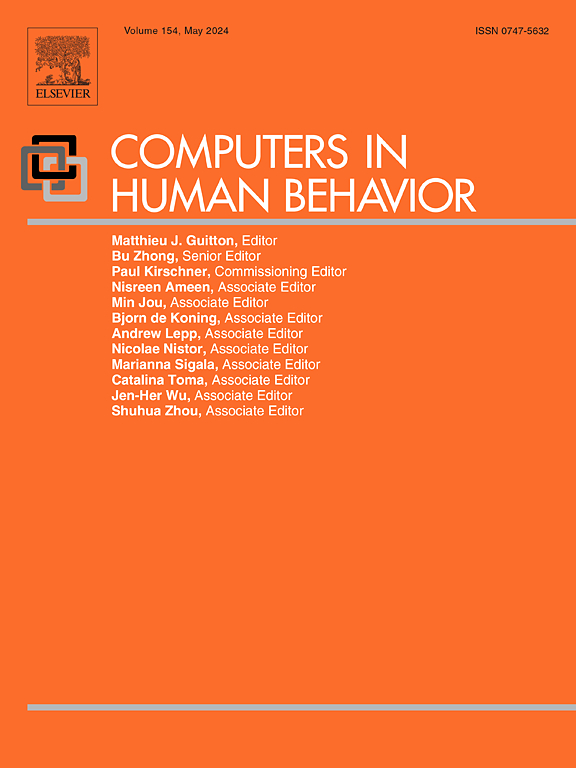Embracing the Metaverse: User perception and acceptance of the Metaverse in education
IF 8.9
1区 心理学
Q1 PSYCHOLOGY, EXPERIMENTAL
引用次数: 0
Abstract
The COVID-19 crisis accelerated the development of virtual educational tools, including immersive virtual technologies. This study explores the perception and acceptance of Metaverse use in education among individuals with prior experience. A quantitative approach was applied using the METAEDU scale and the Technology Acceptance Model (TAM). As one of the first studies to validate the METAEDU scale, it offers a reliable tool to measure user acceptance. A total of 315 participants were surveyed in January 2024 through a market research platform. Data were analyzed using SmartPLS4 software. Results confirmed: (1) certain METAEDU variables significantly impact perceived ease of use (PEOU) and perceived usefulness (PU); (2) attitude (AT) and creative thinking (CT) influence behavioral intention to use (BITU); (3) PEOU and PU affect AT; and (4) age, gender, and education level act as moderating factors. These findings have important implications for educational institutions adapting to evolving student needs. Validating the METAEDU scale highlights the importance of diverse learning dimensions and provides a robust tool for evaluating the effectiveness and accessibility of Metaverse-based education. Institutions should focus on applications that are both pedagogically valuable and personally engaging for students. Furthermore, demographic differences reveal nuanced variations in adoption, emphasizing the need for customized strategies to support diverse user groups. By understanding these factors, educational organizations can better design and implement virtual learning environments, ultimately enhancing the overall educational experience and fostering greater acceptance of emerging technologies.
拥抱虚拟世界:用户在教育中对虚拟世界的感知和接受
COVID-19危机加速了虚拟教育工具的发展,包括沉浸式虚拟技术。本研究探讨了具有先验经验的个体在教育中对虚拟世界使用的感知和接受程度。采用了METAEDU量表和技术接受模型(TAM)的定量方法。作为首批验证METAEDU量表的研究之一,它提供了一个可靠的工具来衡量用户的接受程度。2024年1月,共有315名参与者通过市场研究平台接受了调查。数据分析采用SmartPLS4软件。结果证实:(1)某些METAEDU变量显著影响感知易用性(PEOU)和感知有用性(PU);(2)态度(AT)和创造性思维(CT)影响行为使用意向(BITU);(3) PEOU和PU影响AT;(4)年龄、性别、文化程度是调节因素。这些发现对教育机构适应不断变化的学生需求具有重要意义。验证METAEDU量表强调了多样化学习维度的重要性,并为评估基于METAEDU的教育的有效性和可及性提供了一个强大的工具。机构应该把重点放在既具有教学价值又能吸引学生的应用程序上。此外,人口统计差异揭示了采用的细微差异,强调需要定制策略来支持不同的用户群体。通过了解这些因素,教育组织可以更好地设计和实施虚拟学习环境,最终提高整体教育体验,并促进对新兴技术的更大接受。
本文章由计算机程序翻译,如有差异,请以英文原文为准。
求助全文
约1分钟内获得全文
求助全文
来源期刊

Computers in Human Behavior
Multiple-
CiteScore
19.10
自引率
4.00%
发文量
381
审稿时长
40 days
期刊介绍:
Computers in Human Behavior is a scholarly journal that explores the psychological aspects of computer use. It covers original theoretical works, research reports, literature reviews, and software and book reviews. The journal examines both the use of computers in psychology, psychiatry, and related fields, and the psychological impact of computer use on individuals, groups, and society. Articles discuss topics such as professional practice, training, research, human development, learning, cognition, personality, and social interactions. It focuses on human interactions with computers, considering the computer as a medium through which human behaviors are shaped and expressed. Professionals interested in the psychological aspects of computer use will find this journal valuable, even with limited knowledge of computers.
 求助内容:
求助内容: 应助结果提醒方式:
应助结果提醒方式:


